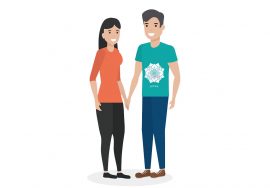
AYURVEDIC SELF MASSAGE TECHNIQUES
Since Ayurveda is a complete science and a way of life, it includes very detailed guidelines,which, whenapplied, can benefit us in all aspects of life, either directly or indirectly.
Massage is an integral part of Ayurveda. Specific massage techniques are mentioned for adults, infants, the elderly, for women during pregnancy, after delivery of a baby, and for a newly born baby.
Broadly speaking, there are two main types of massage, i.e. “Ruksha” which is dry massage, sometimes called “GharshanKriya”, which means rubbing vigorously with dry hands or with some dry object; and another type is called “Snehan”, in which some kind of “Snigdha” (greasy/lubricating) substance, e.g. oil/ghee (clarified butter), etc. is used for massaging.
Oil massage helps to create a lubricating and soothing effect in one’s body. It helps to pacify and regulate Vata (air element), improves blood circulation, moisturises the skin, corrects many skin disorders, relieves muscular and joint pain, induces good sleep, increases and maintains energy level, etc.
Normally, oil massage should be donein the morning, minimum 24 minutes (1 Ghadi) before taking shower. If oil massage in the morning is not possible due to time constraints, then “GharshanKriya” – rubbing the body vigorously with the hands or with a dry brush meant for body brushing – should be done before taking a bath.
In India, there is saying – “garamnahaye, thandakhaaye, vaidyakepaaskabhinajaaye”which means – if a person warms his body up before taking bath with normal water, and eats calming & soothing “sattvic” food; he will not need to see a doctor. This means that one should first warm up his body by rubbing the skin on different parts of the body vigorously, and then take bath with normal water; also, one should consume more calming and soothing food, avoiding hot and pungent food as much as possible, in order to remain healthy.
For oil massage, specific oils are recommended as per one’s “Prakruti” (constitution), “Vikruti” (imbalance/current state of health), age, occupation, season, time of day, etc.
Common oils which are used and can be beneficial to almost everyone are: sesame oil (white sesame oil in hot weather and black sesame oil in cold weather), mustard oil (in cold weather), coconut oil (in hot weather), Ashwagandha oil (for the whole body), Brahmi oil (for the head), Shatavari oil (specifically for women, to be used on the lower abdomen and in the groin area) and Mahanarayan oil (for the whole body).
For young couples who want to start a family, Ayurveda recommends a combination of Mahanarayan oil and Prasarini oil for massaging the whole body. In particular, the lower abdomen and lower back should be massaged regularly with this oil combination to improve energy flow towards the second chakra, which controls the water element and thus influences the quantity and quality of the reproductive tissue – semen/sperms in men and ova/egg in women. Regularly massaging the lower back and lower abdomen also helps to improve blood circulation around and towards the reproductive organs of men and women, thereby increasing the chances of conception.
After conception, during pregnancy, Ayurveda recommends Shatavari oil for massaging the lower abdomen and the groin area; and Ashwagandha oil for massaging the lower back. Shatavari oil helps to increase fluid within the womb for nurturing the baby, prevents miscarriage and also ensures normal delivery of a healthy baby. Ashwagandha oil helps to strengthen the back by pacifying Vata, hence reducing/preventing back pain during pregnancy and also post-delivery.
After delivery,at least for 42 days, a combination of different oils is recommended for nursing mothers and their babies. For example, a combination of Ashwagandha, Mahanarayan andPrasarini oils is recommended for the whole body, particularly around the lower abdomen, stomach and lower back region. This helps to eliminate the excess air accumulated in the uterus after the delivery and thus normalises the size of the uterus.
A combination of Shatavari oil and pure castor oil is recommended for massaging the breasts of the nursing mother. This helps with proper lactation, increases the quantity of breast milk and also improves the quality of breast milk. Regular massage with these oils ensures easy flow of the milk and prevents any discomfort for the nursing mother, e.g. hardness & pain in the breast, soreness in the nipples, etc.
Ayurveda also recommends regular massage for a new born baby. A combination of pure almond oil and white sesame oil is highly recommended. Almond oil is a natural source of vitamin E, which is good for the baby’s skin, while sesame oil is a good source of calcium, which is essential for the muscle and bone tissues of a new born baby. Thus, regular massage ensures proper and normal overall growth of the baby.
The simplified procedure of doing self-oil massage is as follows:
- Start from the feet, rubbing the oil on the soles with sliding movements using yourhands, then massage the legs moving the hands upwards towards the hip joints and groin area. Particularly on the knees – rub the oil while moving your hands in a circular motion, clockwise and anticlockwise.
- Then massage the lower back, moving your hands outwards starting from the spine towards the hip bones.
- Then rub some oil gently on the lower abdomen and the stomach while moving your hands in a clockwise and anti-clockwise direction.
- Then rub some oil on the chest, moving your hands diagonally up and down, to and fro, from the shoulders to the rib cage – women should massage their breasts moving their hands clockwise on the right breast and anti-clockwise on the left breast.
- Then massage the arms. On the upper arms, the hands should move inwards and on the lower arms – from elbows to the wrists – the area should be massaged by moving the hands outwards.
- Next, massage your shoulders by moving your hands in inward circular movements.
- Then massage the fingers by applying a little oil on each finger, interlock the fingers and pull/move your hands outwards, alternating between both hands/fingers.
- Then massage your arms, moving your hands upwards from the wrists to the shoulders.
- Then rub some oil on the neck, moving your hands from the nape of the neck to the throat.
- Next,rub some oil around the ears with the index and middle fingers, moving them up and down, back and forth, making a semi-circle while moving the fingers around the ears.
- Then massage the face/cheeks by moving your palms from the sides of the nose towards the ears.
- And at the end, massage your head for a couple of minutes, using yourfinger tips; finishing off by pressing the head with the palms.
One should regularly massage his/her body at least twice a week. In cold weather, one can do it more often to prevent the skin from becoming dry and dull, and also to prevent several Vata disorders.
To book an online appointment at Ayuryoga, with our Ayurveda/Yoga Expert Mr. Vinod Sharma Hong Kong please click here.
DISCLAIMER : This information is intended for educational purposes only & does not constitute expert medical advice, nor is it meant to replace medical recommendations by a medical practitioner. Always consult a qualified Ayurveda Doctor/Health Professional/Yoga Guru for your specific medical needs before taking any herbal health supplements, and/or practicing Ayurveda &Yoga.












